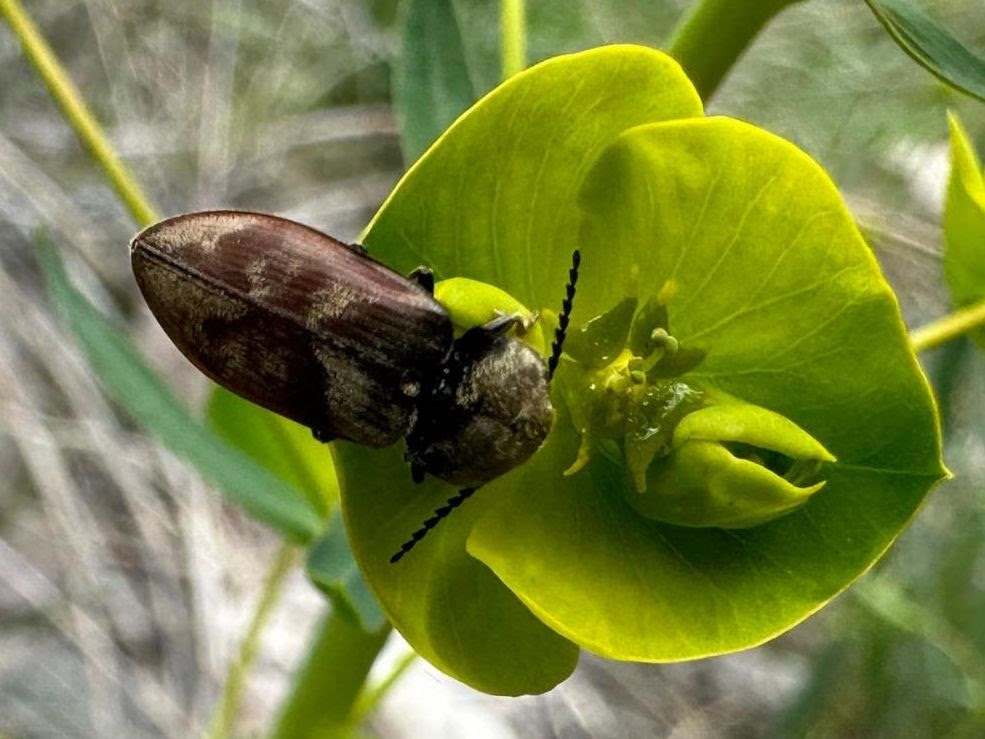And we’re off! Insect activity has exploded in the last week and shows no signs of slowing down. With more warm weather in the forecast, local flowers are finally in bloom and the bugs are out in full force. Get out there, sit by some flowers, and see what comes by (and hope that the smoke clears up soon!)
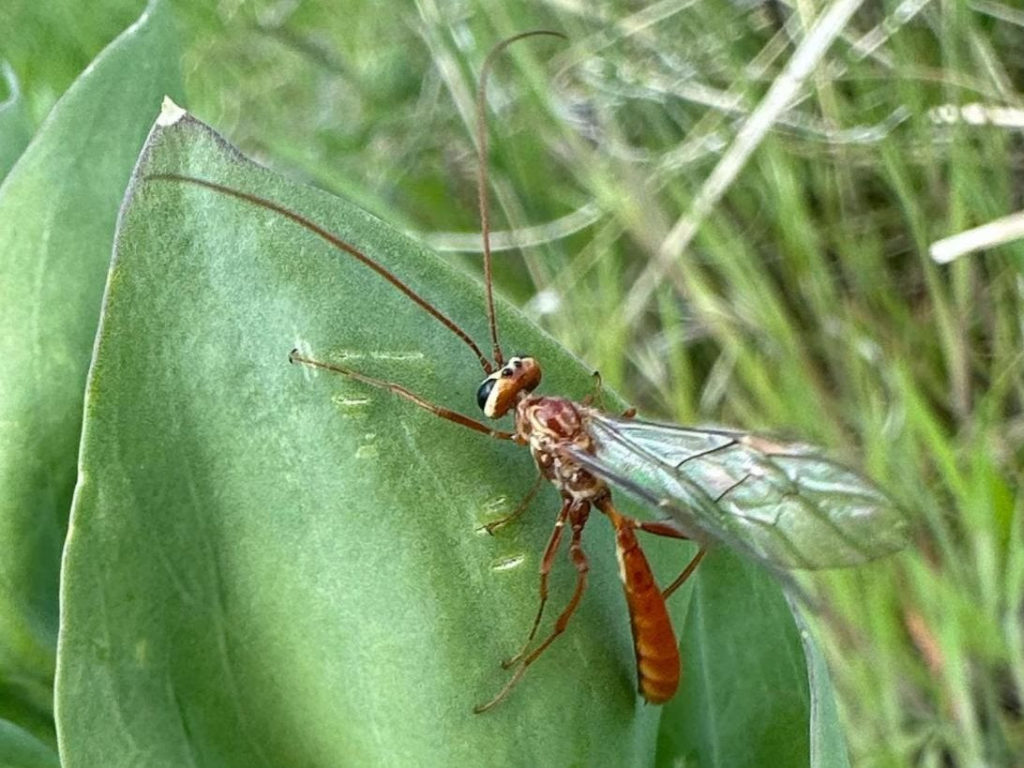
Short-tailed Ichneumonid
Ophioninae
While we believe this wasp belongs to the genus Ophion, differentiating wasps in the Ophioninae subfamily requires close examination (and occasionally dissection). Like other Ichneumonid wasps, they parasitize their prey, laying eggs inside their host’s body. Unlike most wasps, however, some Ophioninae species are nocturnal, flying at night and and only seen when they are drawn to lights (like moths). How fortunate that this individual happened to be out in the daytime!
Rose Marchak, May 12th, 2023. Mt. Jumbo, Missoula, MT.
Salmonfly Cicada
Platypedia areolata
It takes five years for these insects to complete their lifecycle, spending all but a few weeks of that time underground. Unlike the massive, all-at-once, emergence of “periodical” cicada species in the central and eastern US that emerge every 13 or 17 years, Salmonfly Cicadas are an “annual” cicada, meaning that individuals emerge and are present every year.
Glenn Marangelo, May 14th, 2023. National Bison Range, Charlo, MT.
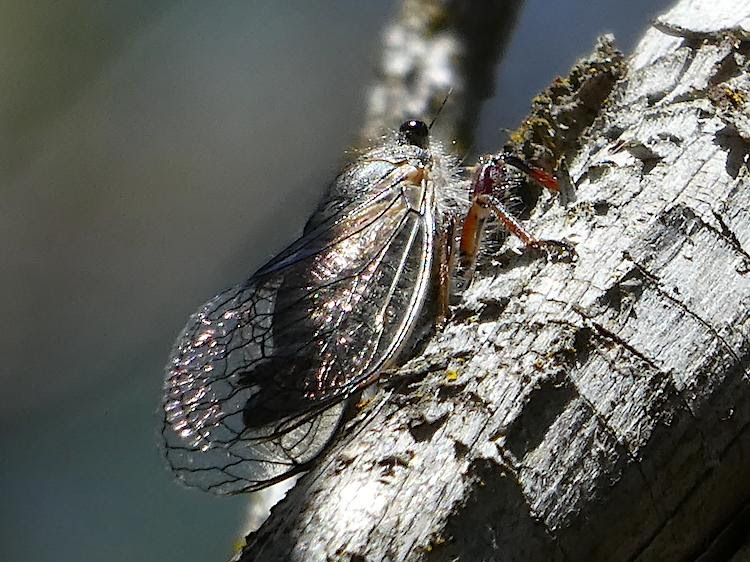
Flatheaded Poplar Borer
Dicerca tenebrica
The flatheaded poplar beetle belongs to the family Buprestidae, or “jewel beetles.” Many species in this family exhibit striking metallic colors, but some, like the emerald ash borer are notorious forest pests. As its name suggests, D. tenebrica feeds on poplars, but has been known to feed on pines in northern regions. Adults can be seen flying from April to November.
Kelly Dix, May 15th, 2023. Missoula, MT.
Attractive Running Spider
Rhysodromus histrio
This attractive spider may look like a wolf spider at first – and even hunts down her prey in a similiar fashion – but running crab spiders belong to a family all their own. Their cepholothorax has a more “flattened” shape than wolf spiders, and when compared side by side, they certainly seem “leggier.” These spiders are very active, and often found traversing plants to hunt their prey, like this R. histrio who managed to ambush a fly while exploring some lupine.
Rose Marchak, May 12th, 2023. Mt. Jumbo, Missoula, MT.
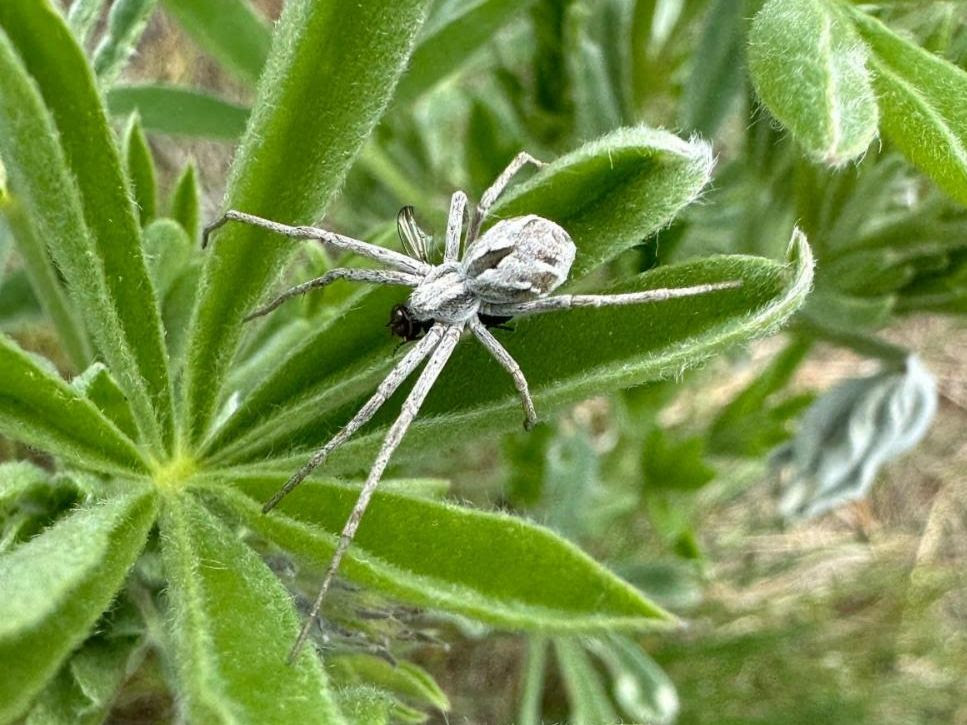
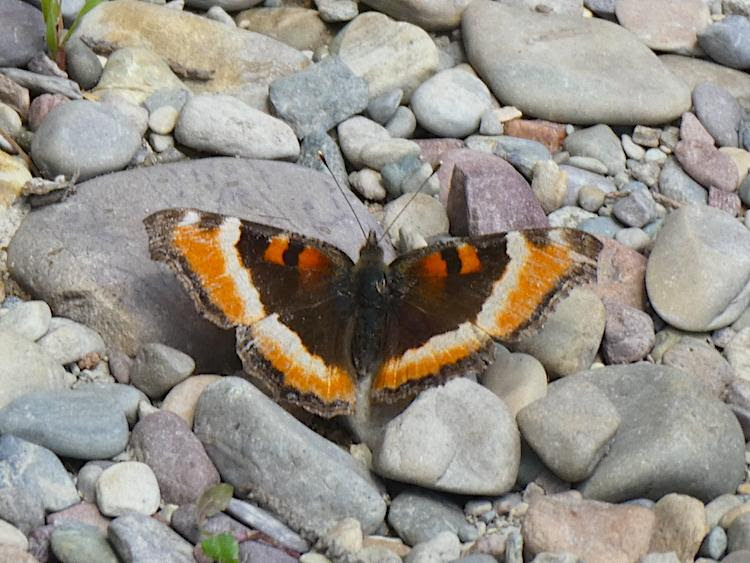
Milbert’s Tortoiseshell
Aglais milberti
Milbert’s tortoiseshell’s – along with seven other hardy butterfly species in western Montana – have special “antifreeze chemicals” to help them overwinter as adults. A cozy hibernaculum, which could be a hollow tree cavity, a crack in bark, or deep leaf litter, protects them from the elements. After literally chilling out for three months, they may be seen flying as early as mid-February on sunny, 50-degree days. By April, they are actively looking for food and mates.
Glenn Marangelo, May 14th, 2023. National Bison Range, Charlo, MT.
Leaf Beetle
Chrysomela confluens
With their distinctive patterning and alien-like larvae, leaf beetles in the genus Chrysomela are often confused as ladybugs. However, as their name suggests, leaf beetles are not predatory, instead feeding on the leaves of willows and poplars. Identification can be difficult, as many species within this genus look similar.
Brenna Shea, May 15th, 2023. Missoula, MT.
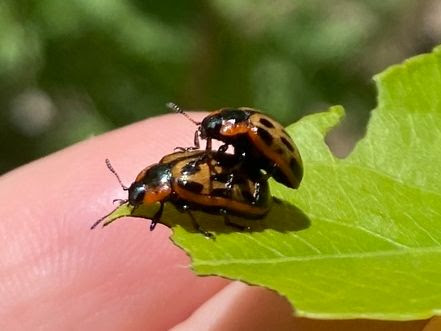
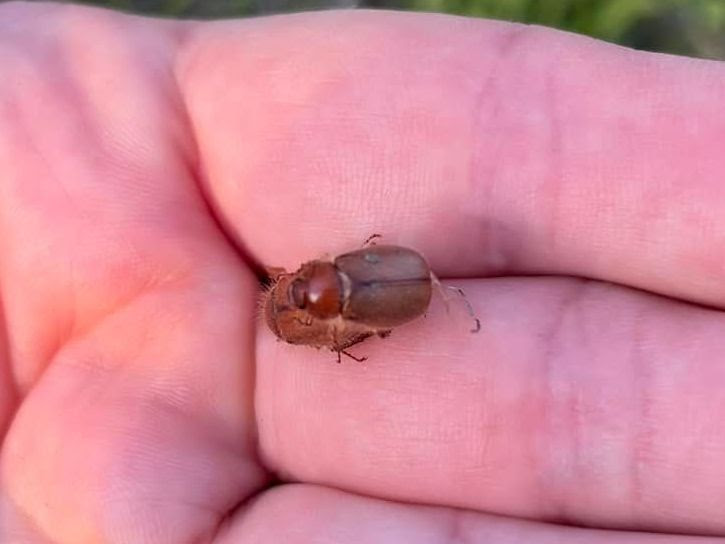
May Beetles
Phyllophaga tristis
Many people associate May beetles with the large, clumsy beetles that collide with well-lit windows at dusk. We cannot speak to this minuscule species’ flight capabilities, but whoever named this species may have some idea. The genus, Phyllophaga, is well-known to mean leaf-eating, as adults feed on plant leaves; but the species name, tristus, means sad, morose, and melancholy. Bummer.
Kate Stone, May 12th, 2023. Missoula, MT.
Bordered Orbweaver
Larinioides patagiatus
The bordered orb weaver is part of the family Araneidae, a family renowned for their orb-weaving habit. This species, unlike others in its genus, often builds its web in shrubs and bushes rather than human-made structures. It also seems to be less associated with open-water habitats. During the daytime these beauties hide in a silk retreat, but if you’re lucky, you may get to see one!
Glenn Marangelo, May 14th, 2023. National Bison Range, Charlo, MT.
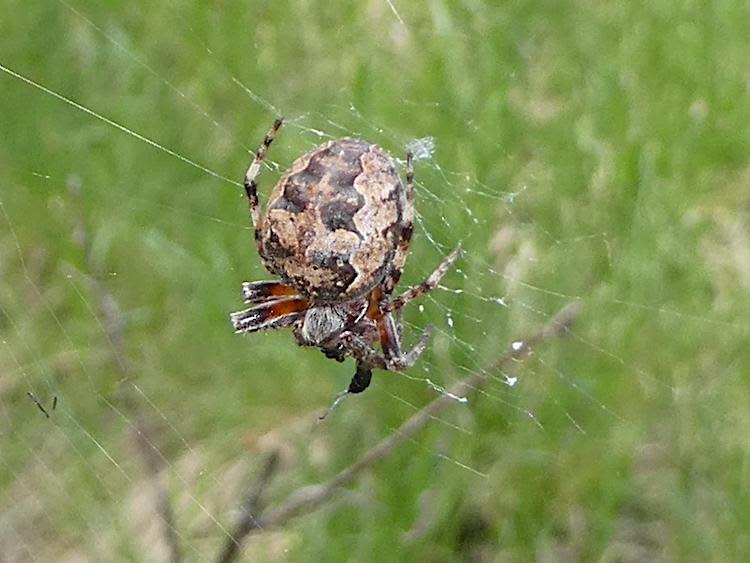

Metallic Click Beetle
Selatosomus semimetallicus
Not much is known about this stunning click beetle; as a member of the Elateridae (click beetles), it performs the family’s characteristic “click” as a predator avoidance strategy. But there is little information on identification or range. To date, there are no reported sightings of this species in Montana on either iNaturalist or BugGuide; of course, until now.
Anne Davis, May 14th, 2023. Barmeyer trail, Missoula, MT.
Parasitized Cutworm Moth
Noctuinae & Euplectrus sp.
We believe this caterpillar belongs to the Noctuidae family – owlet moths – but the really interesting insect in this photo hasn’t hatched yet. The green clumps on the caterpillar’s back are parasitoid wasp eggs. We believe the eggs belong to a wasp in the genus Euplectrus, who specialize on parasitizing caterpillars in a variety of Lepidopteran species. The eggs are anchored to the caterpillar’s back and once they hatch, the unfortunate caterpillar will become the wasp larvae’s first meal.
Rose Marchak, May 12th, 2023. Mt. Jumbo, Missoula, MT.
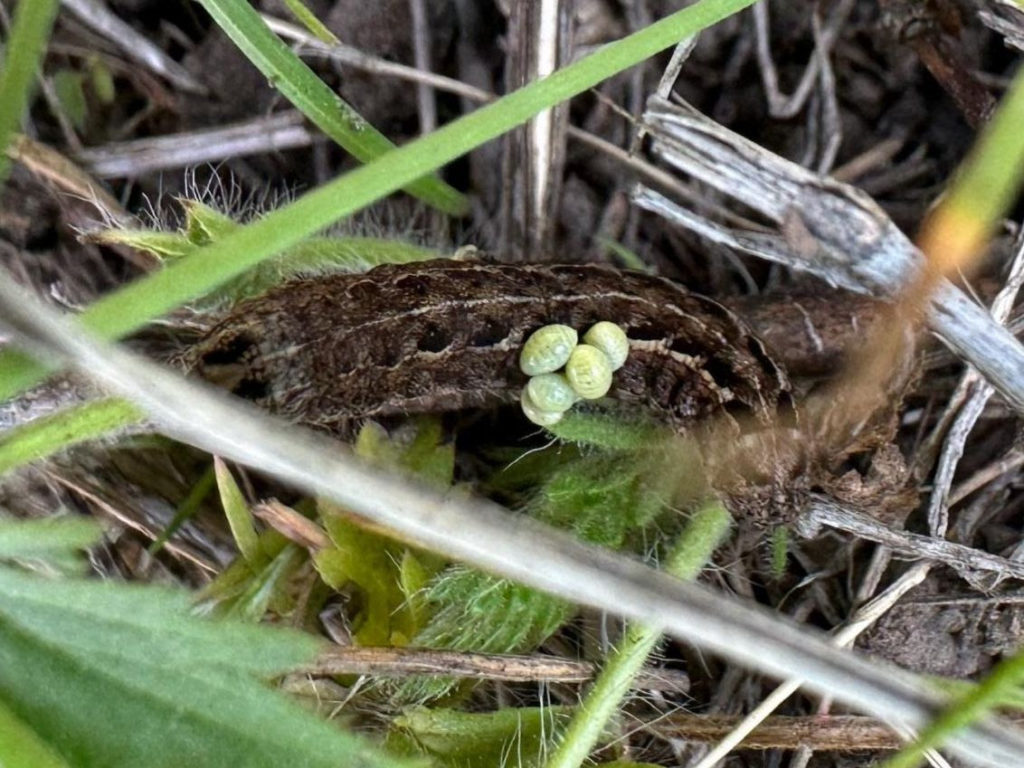
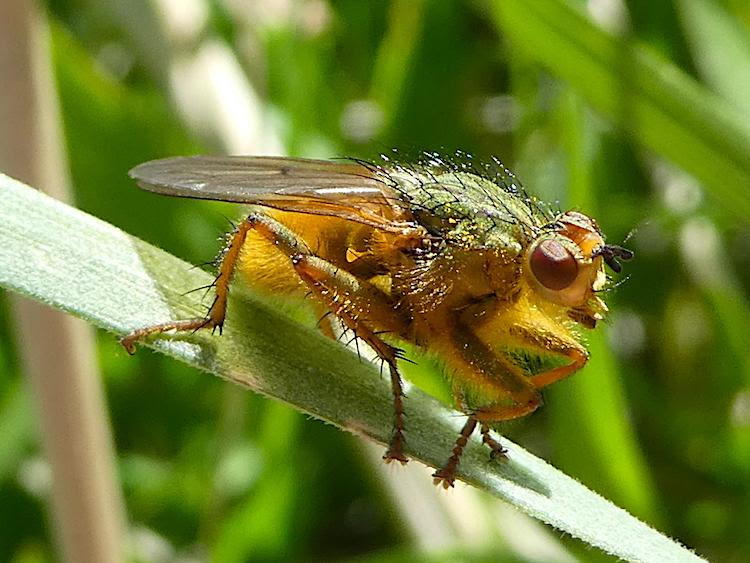
Golden Dung Fly
Scathophaga stercoraria
Luckily for our identification efforts, this is a male Golden Dung Fly. They are a bit easier to identify than the grayer females since they are bright yellow or golden in color. These small flies have multiple generations a year and can be found from spring through the fall. The adults lay their eggs on dung, which the emerging larvae feed upon. After pupating and becoming an adult, their diet switches to preying on other fly species and insects.
Glenn Marangelo, May 14th, 2023. National Bison Range, Charlo, MT.
Click Beetle
Prosternon sp.
Gently pick up any click beetle (family Elateridae) and you’ll not only hear the clicking sound they make, you’ll see your little friend launch into the air. These beetles have a special spine on the underside of their thorax. They use their muscles to arch their bodies, insert the spine into a special groove, and then continue to contract their muscles until the spine eventually pops out of the groove. The spring-loaded energy sends the beetle flying. They use this “click” to avoid being eaten and right themselves in case they end up on their back.
Rose Marchak, May 12th, 2023. Mt. Jumbo, Missoula, MT.
